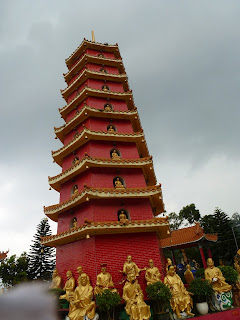Thursday, August 16.
In the northeastern New Territories lies a town called Tai Po (大埔):
In the northeastern New Territories lies a town called Tai Po (大埔):
The midway stop between the mainland and Tsim Sha Tsui on the historic Kowloon-Canton Railway (KCR), the town grew rapidly as a rest stop for travelers from Canton (Guangzhou) and Hong Kong.
Today, designated as one of Hong Kong's New Towns, it is the site of the Hong Kong Railway Museum. with the old Tai Po station serving as the location.
 |
| Old paper KCR tickets. |
 |
| The old manual switches. You can see a modern train whiz by in the back. |
and the original terminus had a picturesque view of Hong Kong Island:
There was a carriage set on display:
Following the traditional British system, there were three classes.
Third:
Second:
and this:
The idea of separate classes of travel still exists on the current KCR line - merged with MTR in 2007 and renamed the East Rail Line - with a first class cabin located in the middle of what would otherwise be a standard rapid transit train.
Spur lines used smaller, almost cartoon-like cars, running on a very narrow track gauge:
For lunch we went to the famous Tai Po Market (大埔墟街市, lit. "Tai Po Market market"), a rather modern (air-conditioned!) facility built on the site of the old market complex.
At the top is the cooked food centre, similar to ones adopted at other newer markets.But this one is massive.
there are many shops specializing in noodle dishes topped with fish balls:
and fried fish patties.
I found that it was nothing special.
...and when I say many shops, I mean many shops:
 |
| Yeah, that whole board. |
Taking the East Rail line back to Sha Tin, the advances in technology over the years is astounding:
So that's one of the legacies that the British left for the city.There are two other influences on Hong Kong that stem from much more ancient traditions.
The first one is Buddhism.
 |
| Yeah, they're not kidding. |
As we approach the actual monastery, the bodhisattva statues become more and more imposing (the last ones, of Guanyin, have giant halos around them!)
There are an inordinate number of (all unique!) buddha statues in the main temple. I will only assume that the number is ten thousand. (No photos inside!)
You can walk up the pagoda in the courtyard:
which will reveal a great, breezy top with some view of Sha Tin below you.
On the way down, we were greeted by some wild monkeys.
The other influence is the traditional Chinese spirituality.
This is Che Kung Temple (車公廟) in Tai Wai, dedicated to a deified general of the late Southern Song Dynasty, on its last legs before its fall in 1279. The original temple, built near the end of the Ming Dynasty in 1644, was replaced in 1993 by a new, grander temple.
The main hall is in the centre here:
again, no photos inside.
There is both a bell on the east:
and a gong on the west,
presumably used to signal some sort of time.
A well-wishing statement is placed above your head on the way out.
While these historical influences have shaped much of what Hong Kong is today, there is no doubting the contribution the modern interconnectedness of the world has made to local culture and thinking.
Just take a look at the desserts:
Egg pudding. in the shell.
Tofu pudding. With mangoes. Lots and lots of mangoes.
and fruits. Lots and lots of fruits.Or the architecture:
Or even just the ships that dot the sea surrounding the territory, night and day.















































No comments:
Post a Comment